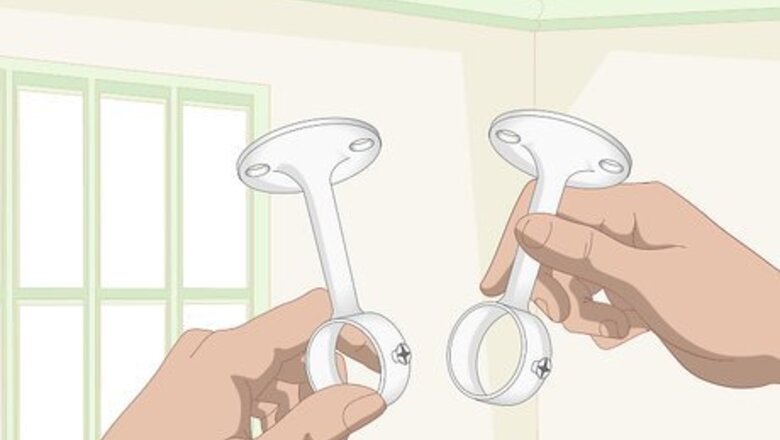
views
Using a Rod and Brackets
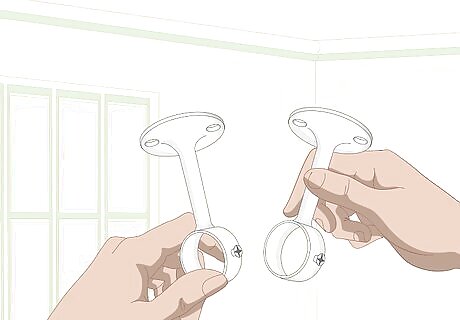
Find rod brackets specifically made for the ceiling. Brackets meant for the wall will have a shallower "hook," which may not work for the ceiling. You can find ones specifically for the ceiling online or in most home improvement stores. When looking for a rod, choose one that's 8 to 10 inches (20 to 25 cm) wider than your window. Also, pick up some hollow wall anchors (molly bolts) if your brackets don't come with them and you have plaster ceilings; they should be the same size as the screws that come with your kit. Screws work fine if you're going into wood, but with plaster, you need to anchor the holes with something sturdier. If you're not sure what to get, ask for help at the home improvement store. Bring in your brackets so they can see them. If you're using anchors, make sure they're made to support the weight you're hanging up. Anchors come in different weight ratings.
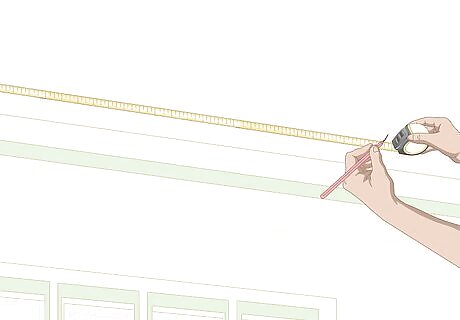
Measure and mark where you want the brackets to be. The brackets should come out 2 to 3 inches (5.1 to 7.6 cm) from the wall so the curtains aren't right against the window. Then, you should place the brackets either right at the outer edges of the window or 2 to 3 inches (5.1 to 7.6 cm) past the ends of the window on either side. Mark where the brackets should go with a pencil. Keep in mind, you're aiming for the curtain rod to extend 4 to 5 inches (10 to 13 cm) on either side. However, the end decoration may affect how far you want the brackets out from the window. If the decorations are wide, you may want to place the brackets closer to the width of the window so that there's room for the caps to extend past the brackets. Always hold the rod up to your marks to see if it looks right. If you're going to be doing several windows of the same size, try making a template out of cardboard. Mark where the edges of the windows are and where you should drill the holes on the cardboard. Then you can use it to easily figure out where to drill above each window.
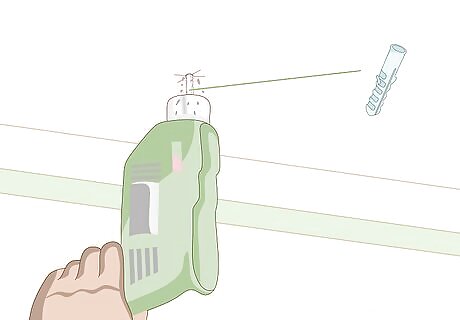
Drill a pilot hole that's the width of the hollow wall anchors you'll use. If your ceiling is plaster, you should use hollow wall anchors. Typically, you drill a hole that's the same size as your anchors. So if the anchor is ⁄8 inch (3.2 mm), use a drill bit that size. Press the bit against the place you've marked. Turn the drill on and slowly press it into the ceiling, making sure you go all the way through the plaster. Drill a hole for each anchor you need to put in. You'll need an anchor for each hole in the bracket. If you do have wood ceilings, you can simply screw in the brackets. Always wear protective goggles when drilling into the ceiling so nothing gets into your eyes.
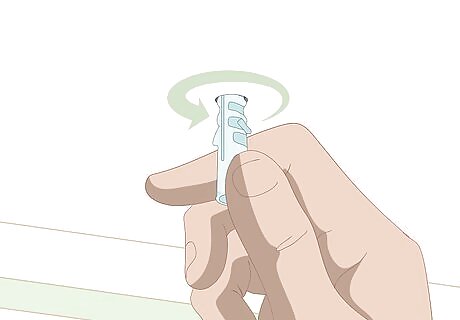
Insert the hollow wall anchor into the holes and screw it to the right. Press the anchor in with your hand until the teeth on the back catch in the plaster. Use a screwdriver or drill to turn the screw to the right. Just the screw should turn, not the anchor. This will tighten up the anchor behind the screw. When it feels tight, you can take the screw out of the anchor. To take the screw out, turn it to the left with a screwdriver or drill. Repeat this process with all the anchors. You should have a "reverse" button on your drill to make it go to the left as needed.
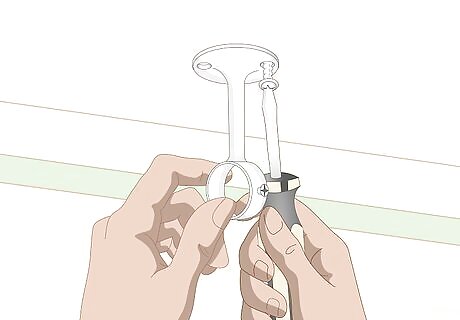
Place the bracket over the anchors and screw it into place. Hold the bracket against the ceiling. Set a screw into one of the holes, turning it lightly into the anchor below. Place the tip of the drill at the head of the screw, fitting it into place. Turn the drill on slowly and let it rotate the screw into place by turning it to the right. You may want to have someone else hold the bracket while you use the drill. Make sure the brackets are going the direction you want to hold the rod properly.

Put the curtain on the rod and hang it in place. Slide the curtain over the rod. If you're using the kind with eye holes, alternate going front to back and back to front so that it pleats the curtain and hangs properly. Screw the end caps on and hang the rod in place by setting it onto the hooks, centering it between the brackets. To hide the bracket, make sure you slide the rod into the front of the curtain (and out the back) first when putting it on, then through the back and out the front. That will create a concave effect that you can slide around the bracket to hide it. In some cases, you may need to put the rod in place before you screw the end caps back on.
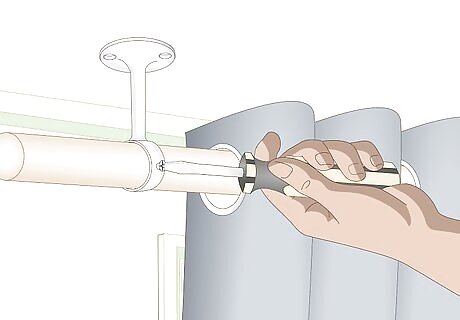
Tighten the screws over the rod if yours has them. If you had to remove the end caps to slide the curtain into place, then your brackets likely have screws that help hold the rod. Simply use a screwdriver or drill to tighten them, which will help keep the rod from moving around.
Installing a Track for Curtains
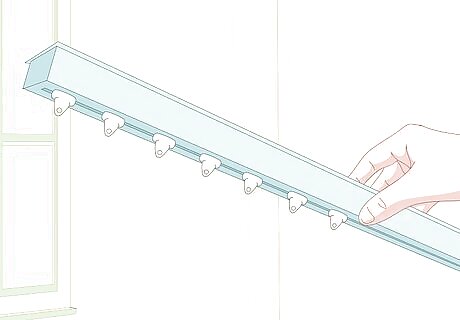
Find a track bracket specifically for the ceiling. These brackets are a long piece of metal with tiny loops in them for hanging curtains. Opt for one that's 8 to 10 inches (20 to 25 cm) wider than your window, allowing the curtain to expand past the edges. You can find these online or at most home improvement stores. If you have plaster ceilings, you'll also need hollow wall anchors (molly bolts) if your kit doesn't come with them. Pick ones that are the same size as the holes in the brackets. These help anchor the screws into the ceiling. If you have a wood ceiling, just screws are fine.
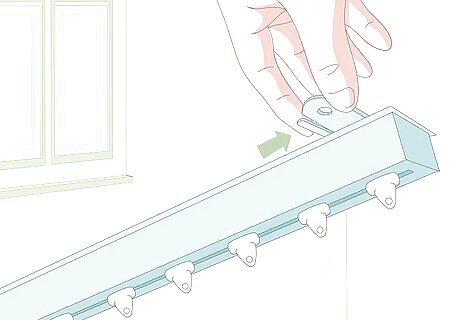
Add the braces to the brackets as needed. Some kits come with little braces that you snap into place on the back of the track. Your kit should tell you how to install them, but typically, you just slide them over one edge of the track and pull it toward the other side. Then, you snap it into place by pressing down. Some brackets have little "arms" you'll need to pull open and then you can put it in place and close the arms. Spread the brackets out evenly along the track. They can move back and forth.
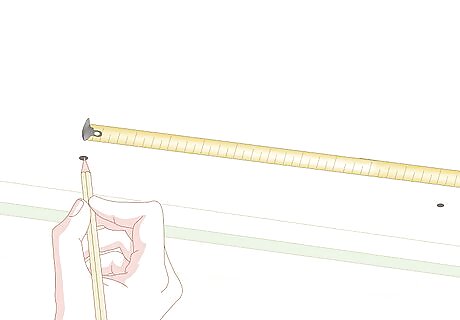
Measure where the anchors will go and place a dot at each one. Hold a tape measure up and mark a spot 2 to 3 inches (5.1 to 7.6 cm) from the wall, depending on how far out you want your curtains. Hold the track up at this spot. Center it above the window, using a tape measure as needed to help you find the middle. Once you have the track where you want it, mark where each of the anchors needs to go with a pencil. If you're having trouble holding the track in place and marking at the same time, use painter's tape to temporarily attach it to the ceiling. Take the track down again before drilling the pilot holes.
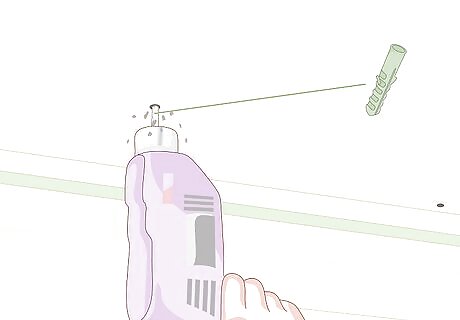
Drill pilot holes for the wall anchors. The pilot holes should be the same size as the anchors. Therefore, if you have a ⁄8 in (0.32 cm) anchor, you need a drill bit of the same size. Place the drill against the ceiling, making sure it's perfectly perpendicular. Then, turn the drill on slowly. Let it do the work of drilling the hole as you apply gentle pressure. Make a hole for each place you've marked. Wear safety glasses while you drill to protect your eyes.
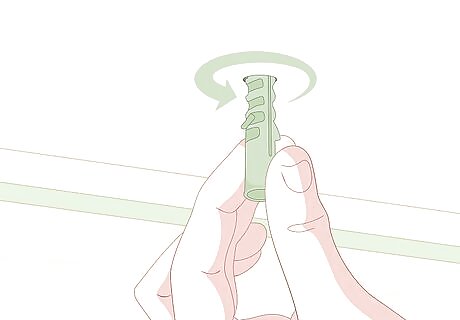
Press and screw each anchor into place. Push the anchor into the plaster with your fingers. The teeth on the anchor should catch. Then, use a Phillips head screwdriver or screwdriver bit for your drill to turn the screw to the right. The anchor should be held in place by the teeth. As the drill turns, the metal pieces behind the anchor will tighten up. When it feels tight, you can stop and pull the screw out. Turn the screw to the left to pull it out. You can use the screwdriver or a drill bit, but make sure to reverse the drill to pull it out. Most drills have a "reverse" button. Repeat the process for all the holes.
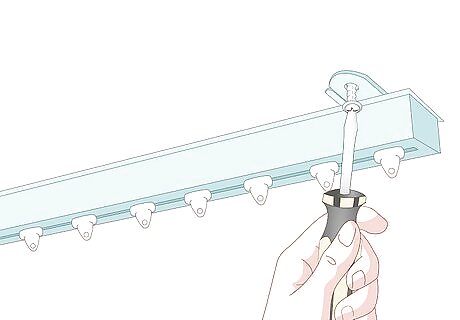
Screw the track into place. Hold the track up against the anchors. Begin at one end, and put the screw through the track's braces to the anchor below. Use your fingers to screw it in a little until it catches, then place the tip of the drill against the tip. Turn the drill on slowly to screw it into place. Repeat the process with each screw until you've done them all and the track is held in place.
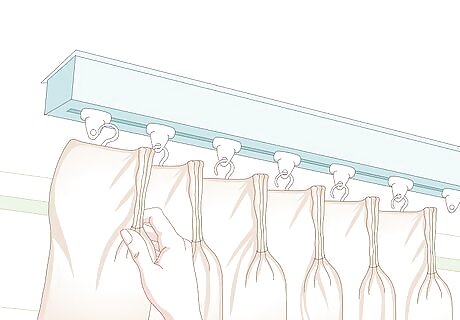
Insert the curtain hooks into the loops on the track. You should have loops all along the bottom of the track. Start at one end, and grab a hook on one end of the curtain. Put one hook in each loop you see. Make sure not to skip any, as that will leave gaps in your curtains. When you've reached the last loop and hook, you're done. If your curtain doesn't have the hooks, you can insert them in place at the top of the curtain on the back. The holes should be marked, and you just slip it underneath the bottom edge of the hem and out through the top. You can also install pull wands in the middle of the track simply by hooking them into place over the loops.



















Comments
0 comment